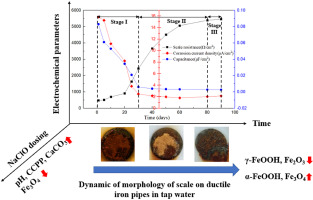当前位置:
X-MOL 学术
›
Water Res.
›
论文详情
Our official English website, www.x-mol.net, welcomes your
feedback! (Note: you will need to create a separate account there.)
Early period corrosion and scaling characteristics of ductile iron pipe for ground water supply with sodium hypochlorite disinfection.
Water Research ( IF 11.4 ) Pub Date : 2020-03-21 , DOI: 10.1016/j.watres.2020.115742 Haiya Zhang 1 , Lvtong Zhao 1 , Dibo Liu 1 , Jun Wang 2 , Xiaojian Zhang 2 , Chao Chen 2
Water Research ( IF 11.4 ) Pub Date : 2020-03-21 , DOI: 10.1016/j.watres.2020.115742 Haiya Zhang 1 , Lvtong Zhao 1 , Dibo Liu 1 , Jun Wang 2 , Xiaojian Zhang 2 , Chao Chen 2
Affiliation

|
The corrosion and scaling phenomenon have crucial impact on drinking water distribution systems (DWDS), which might lead to pipe blockage or leakage, colored water and other chemical stability issues. In this study, a simulating pipe system with continuous water flow was prepared to investigate the characteristics of corrosion and scaling on ductile iron pipe transporting ground water with sodium-hypochlorite (NaOCl) disinfection. Electrochemical assays, such as polarization curves and electrochemical impedance spectra were applied to monitor the corrosion and scaling process. Results showed the morphology and components of scale were closely related with the electrochemical analysis results. The corrosion current density decreased continuously as corrosion and scaling proceeded. The process could be divided into three stages. During Stage I (0-20 days), the corrosion current intensity of low NaOCl dosage experiments (1, 2 mg/L) were higher than those of high NaOCl dosage experiments (5, 10 mg/L). The difference could be explained by different oxidation potentials, pH and CaCO3 deposition. During Stage II (20-80 days), higher proportions of Fe3O4 in scale in experiments with no or low NaOCl dosages restrained the corrosion process and presented smaller corrosion current. Subsequently, the ductile iron surface became passivated and the difference of various NaOCl dosages affecting corrosion and scaling process turned to be negligible during Stage III (80-90 days). A negative linear relationship between the proportion of stable scale component and the corrosion current density was established. Besides the direct corrosion reaction with iron substrate, NaOCl dosing was accompanied by an increase in pH and calcium carbonate precipitation potential values, which affected the early period corrosion and scaling phenomenon greatly.
中文翻译:

次氯酸钠消毒的球墨铸铁供水管道的早期腐蚀和结垢特性。
腐蚀和结垢现象对饮用水分配系统(DWDS)具有至关重要的影响,可能导致管道堵塞或泄漏,有色水和其他化学稳定性问题。在这项研究中,准备了一个连续水流模拟管道系统,以研究用次氯酸钠(NaOCl)消毒的球墨铸铁管道输送地下水时的腐蚀和结垢特性。电化学分析方法,例如极化曲线和电化学阻抗谱,用于监测腐蚀和结垢过程。结果表明,水垢的形貌和组成与电化学分析结果密切相关。随着腐蚀和结垢的进行,腐蚀电流密度连续降低。该过程可以分为三个阶段。在第I阶段(0-20天),低NaOCl剂量实验(1、2 mg / L)的腐蚀电流强度高于高NaOCl剂量实验(5、10 mg / L)的腐蚀电流强度。可以用不同的氧化电位,pH和CaCO3沉积来解释差异。在第II阶段(20-80天)期间,在没有或没有NaOCl剂量的实验中,较高比例的Fe3O4会抑制腐蚀过程,并呈现较小的腐蚀电流。随后,球墨铸铁表面被钝化,并且在阶段III(80-90天)内影响腐蚀和结垢过程的各种NaOCl剂量的差异可以忽略不计。建立了稳定的水垢成分比例与腐蚀电流密度之间的负线性关系。除了与铁底材的直接腐蚀反应外,
更新日期:2020-03-21
中文翻译:

次氯酸钠消毒的球墨铸铁供水管道的早期腐蚀和结垢特性。
腐蚀和结垢现象对饮用水分配系统(DWDS)具有至关重要的影响,可能导致管道堵塞或泄漏,有色水和其他化学稳定性问题。在这项研究中,准备了一个连续水流模拟管道系统,以研究用次氯酸钠(NaOCl)消毒的球墨铸铁管道输送地下水时的腐蚀和结垢特性。电化学分析方法,例如极化曲线和电化学阻抗谱,用于监测腐蚀和结垢过程。结果表明,水垢的形貌和组成与电化学分析结果密切相关。随着腐蚀和结垢的进行,腐蚀电流密度连续降低。该过程可以分为三个阶段。在第I阶段(0-20天),低NaOCl剂量实验(1、2 mg / L)的腐蚀电流强度高于高NaOCl剂量实验(5、10 mg / L)的腐蚀电流强度。可以用不同的氧化电位,pH和CaCO3沉积来解释差异。在第II阶段(20-80天)期间,在没有或没有NaOCl剂量的实验中,较高比例的Fe3O4会抑制腐蚀过程,并呈现较小的腐蚀电流。随后,球墨铸铁表面被钝化,并且在阶段III(80-90天)内影响腐蚀和结垢过程的各种NaOCl剂量的差异可以忽略不计。建立了稳定的水垢成分比例与腐蚀电流密度之间的负线性关系。除了与铁底材的直接腐蚀反应外,











































 京公网安备 11010802027423号
京公网安备 11010802027423号